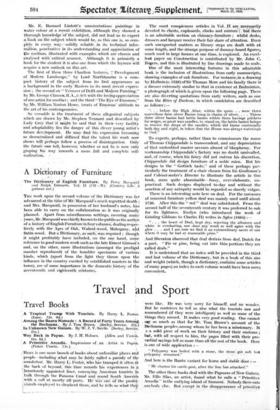A Dictionary of Fiirniture -
guineas net.) '
THE work upon the second volume -of the Dictionary was far advanced at the time of Mi.'Macquoids much regretted death ; and Mrs. Macquoid, in possession of her husband's notes, has been able to carry-on the collaboration- as it was originally planned. Apart from miscellaneous writings, covering many years, Mr. Macquoid was chiefly known to the public as the author of a history of EnglishFurniture in four VOluthei; dealing respec- tively with the" Ages of Oak; Walnut-wood, Mahogany, and Satin-wood. But a Dictionary, as siich,-Was required ; though it might profitably have included, on the one hand, some reference to good modern work Such as the late Krnest Gimson's and, on the other, more illustrations (amongst the prodigal number reproduced) 'of the hunabler specimens of various kinds, which (apart from the light they throw upon the influence in the country exerted by established masters in the town), are of some importance in the domestic history of the seventeenth arid . eighteenth centuries:
The most conspicuous articles in Vol. II are necessarily devoted to chests, _cupboards, clicks and mirrors but there is an admirable section on chimney-furniture ; whilst desks,
dressers and lacquer receive their fair share of attention. Even such unexpected matters as library steps are dealt with at some length, and the strange purpose of dummy-board figures; much used in large houses at one time, is-explored. An excel-
lent paper on Construction is contributed by Mr. John C. Rqgers, and this is illustrated by line drawings made to scale.
One of the most interesting features in this admirable book is the inclusion of illustrations from early manuscripts; showing examples of oak furniture. For instance, in a drawing by Holhein (c.1528)of Sir Thomas More and his family there is a dresser extremely similar to that in existence at Badminton, a photograph of which is giVen upon the following page. There
are also diverting quotations -from early writers, such as one from the Rites of Durham, in which candelabra are described as follows.
". . . before the High Altar, within the quire. . . were three marvellous faire silver Basins hung in chains of silver., . . . Thiese three silver basins had lattin basins within them havinge prickets for serges, or great wax candles, to stand on, the lattin basins beinge to receive the drops of the candles, which- did burn continually both day and night, in token that the House was always watchinge to Cod."
To experts, perhaps, rather than to connoisseurs the name
of Thomas Chippendale is transcendent, and any depreciation of that undoubted master savours almost of blasphemy. For workmanship Chippendale's factory was no .dOubt unrivalled, and, of 'course, when his fancY did not outrun his discretion, Chippendale did design furniture of a noble mien. But his designs in the " Gothick taste," and of these perhaps par- ticularly the treatment of a chair chosen from his Gentleman's and Cabinet-maker's Director to illustrate the article in this
book, seem quite abominable—fussy, over-elaborate, im- practical. Such designs displayed to-day and without the sanction of any antiquity would be regarded as sheerly vulgar. There is an interesting note here on deal. For the carcasses of veneered furniture yellow deal was mainly used until about
1750. After this-the " red " deal was substituted. From the second half of the seventeenth century it was preferred to oak for its lightness. Evelyn (who introduced the Work of Grinling Gibbons to Charles II) writes in Sylva (1664) :— " . . . the heart of Deal„ kept dry, rejecting the albumen and white is everlasting,- nor !does any wood so well agree with the glew . . . and I am sure we find it an extraordinary saver of oak where it may be had at reasonable, price."
And Sheraton Obserired that deal derives from deel, Dutch for a part. "Fir or pine, being cut into thin portions they are
called deals."
It is understood that an index .will• be provided- in the third and 'last volume of the Dictionary, but in a book of this size and weight (which, thoUgh a dictionary, contains some articles of many pages) an index to each-volume would have been morq convenient.






















































 Previous page
Previous page